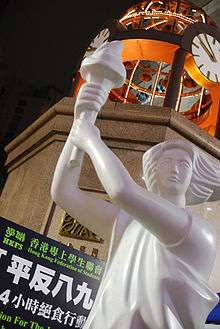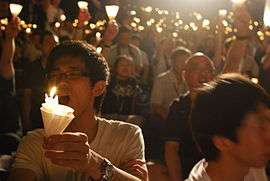Hong Kong Alliance in Support of Patriotic Democratic Movements in China
 | |
| Founded | 21 May 1989 |
|---|---|
| Type | Non-profit organisation |
Key people |
Szeto Wah (founder) Lee Cheuk-yan Albert Ho (current chair) |
| Website | www.alliance.org.hk |
| Hong Kong Alliance in Support of Patriotic Democratic Movements in China | |||||||||
| Traditional Chinese |
香港市民支援愛國民主運動聯合會 or 支聯會 | ||||||||
|---|---|---|---|---|---|---|---|---|---|
| |||||||||
The Hong Kong Alliance in Support of Patriotic Democratic Movements of China (Chinese: 香港市民支援愛國民主運動聯合會; abbr. 支聯會; ) is a pro-Chinese democratic organization that was established on 21 May 1989 in the then British colony of Hong Kong during the demonstration for the students protest in Tiananmen Square in Beijing. After the June 4th massacre, the organisation main goals are the rehabilitation of the democracy movement and the accountability for the massacre. The main activities the organisation holds is the annual memorials and commemorations, of which the candlelight vigil are the most attended, reported and discussed event each year.
Five operational goals
The Alliance has five operational goals:[1]
|
Release the dissidents |
History

In 1989, the sudden death of the former General Secretary of the Communist Party of China (CPC) Hu Yaobang, widely considered a liberal figure within the party leadership, sparked a series of protests at the Tiananmen Square. The Hong Kong Federation of Students (FHKS) visited the in Beijing student protesters and mobilised for the support of the Hong Kong society after they returned to Hong Kong. On 20 May 1989 after Premier Li Peng imposed the martial law, the Joint Committee on the Promotion of Democratic Government (JCPDG), an umbrella organisation of the local pro-democracy activists decided to hold a demonstration at the Victoria Park and marched to the headquarters of New China News Agency (NCNA). On 21 May during the No. 8 typhoon signal, more than a million people marched in the street in support of the Tiananmen protests. The Hong Kong Alliance in Support of Patriotic Democratic Movements of China was founded during the march.
On 4 June 1989, the Beijing government bloodily suppressed the peaceful protest. After the massacre, delegates from more than 200 civil groups elected a 20-member Standing Committee headed by Szeto Wah and Martin Lee to hold the subsequent commemorations and actions. The Alliance helped the "Operation Yellowbird", providing shelters and financial assistance in helping smuggling leaders of the democracy movement out of China. The Alliance also set up a database of the democracy movement and published works related to the movement. It also maintain close relationship with the Tiananmen Mothers initiated by Ding Zilin, a group of family members of the ones who were killed in the massacre and vocally supported the democracy movements in China. Beijing's mouthpiece People's Daily accused the Alliance of having intention to overthrow the Chinese government.[2] Szeto and Lee, who were members of the Hong Kong Basic Law Drafting Committee were unseated by Beijing after the duo resigned from the committee after the massacre.
The annual candlelight vigil at the Victoria Park among other activities has been the most iconic event organised by the Alliance, as it is the most attended consecutive commemoration of the 1989 protests. Tensions were high in 1996, which marked the seventh anniversary of the Tiananmen massacre.[3][4] Residents were not sure whether or not the annual demonstration would continue after the upcoming 1997 sovereignty handover of Hong Kong to the People's Republic of China.[5][4] The eighth anniversary, in 1997, was just before the handover. People in the demonstration speculated that it might turn out to be the last vigil.[6] In 1997, then Chief Executive-elect Tung Chee-hwa attempted to pressurise Szeto into not organising the vigil, and Szeto refused to speak to Tung ever again after three such attempts.[7]
As the protests were largely censored in the Mainland China, the Alliance was one of the main sources of both the mainland and the local people to learn about the event. On the 20th anniversary of Tiananmen Square protests of 1989, the Alliance recorded a large increase in number of the attendees of the vigil, as many young generation attended the vigil. A year before the Alliance also organised events and protests in support of the Charter 08 movement launched by the mainland democracy activists such as Liu Xiaobo. After Szeto Wah, the Alliance's founding chairman died in 2011, the chairmanship was occupied by Lee Cheuk-yan. In 2014, the Alliance opened the June 4th Museum, the world's first memorial museum for the Tiananmen protests. In 2014, Albert Ho took over Lee as the Alliance chairman.
The number of attendees kept in a high level until in recent years the emergence of the localist movement challenged the meaning of commemorating the Tiananmen protests, as some young localists perceived themselves as non-Chinese and disagreed with one of the goals of the Alliance, "build a democratic China". Such view was held by localist scholar Chin Wan, who believed that the Chinese nationalistic sentiment and patriotism the Alliance projected was an obstacle for Hong Kong people to construct a distinct identity.[8][9] Some other criticisms included the overlapping membership of the Alliance and the Democratic Party, the ritualization of the vigil and the ineffectiveness of the Alliance of achieving any of its operation goals. Since 2013 as the Hong Kong–Mainland China conflict intensified, the number of the attendees to the vigil gradually dropped. From 2015 to 16, the number the Alliance recorded dropped from 180,000 to 135,000.[10]
List of chairmen
- Szeto Wah, 1989–2011
- Lee Cheuk-yan, 2011–2014
- Albert Ho, 2014–present
See also
| Wikimedia Commons has media related to Hong Kong Alliance. |
References
- ↑ 關於支聯會 ("About the Alliance") Archived 10 June 2011 at the Wayback Machine. (in Chinese)
- ↑ Weiss, Meredith Leigh; Aspinall, Edward (2012). Student Activism in Asia: Between Protest and Powerlessness. U of Minnesota Press. p. 89.
- ↑ Mickleburgh, Rod (5 June 1996). "Hong Kong Remembers Massacre". The Globe and Mail (Pg. A.1).
- 1 2 Gargan, Edward A. (5 June 1996). "Hong Kong Holds Vigil – the Last? – For Tiananmen Victims". The New York Times. https://www.nytimes.com/1996/06/05/world/hong-kong-holds-vigil-the-last-for-tiananmen-victims.html
- ↑ Mickleburgh, Rod (5 June 1996). "Hong Kong Remembers Massacre". The Globe and Mail (Pg. A.1)
- ↑ The Associated Press (5 June 1997). "Memorial May Be Last in Hong Kong//Tiananmen Square Future in Doubt". Tulsa World. http://www.tulsaworld.com/archives/memorial-may-be-last-in-hong-kong-tiananmen-square-future/article_ae2e8d68-9da6-5130-831c-8b28ad931317.html
- ↑ "董建華 三勸停辦支聯會". 2011-01-03.
- ↑ Ip, Kelly; Phneah, Jeraldine; NectarGan (5 June 2013) "Undampened" Archived 2014-07-14 at the Wayback Machine.. The Standard.
- ↑ Tiananmen massacre remembered at massive Hong Kong vigil, chinaworker.info, 6 June 2014
- ↑ "大會宣布13.5萬人出席維園六四晚會". 2015-06-04.
External links
- Official website (in Chinese)
